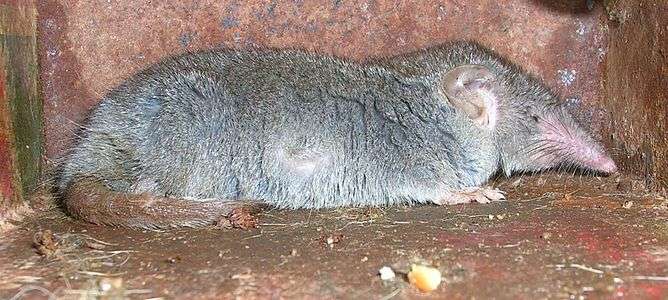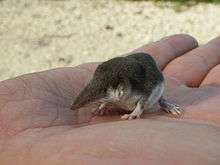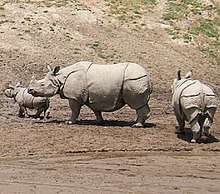List of mammals of Nepal
This list of mammals of Nepal presents mammal species recorded in Nepal, of which one is critically endangered, eleven are endangered, twenty are vulnerable, and four are near threatened. The following tags are used to highlight each species' conservation status as assessed on the IUCN Red List:
| EX | Extinct | No reasonable doubt that the last individual has died. |
| EW | Extinct in the wild | Known only to survive in captivity or as a naturalized populations well outside its previous range. |
| CR | Critically endangered | The species is in imminent risk of extinction in the wild. |
| EN | Endangered | The species is facing an extremely high risk of extinction in the wild. |
| VU | Vulnerable | The species is facing a high risk of extinction in the wild. |
| NT | Near threatened | The species does not meet any of the criteria that would categorise it as risking extinction but it is likely to do so in the future. |
| LC | Least concern | There are no current identifiable risks to the species. |
| DD | Data deficient | There is inadequate information to make an assessment of the risks to this species. |
| Part of a series on the |
| Wildlife of Nepal |
|---|
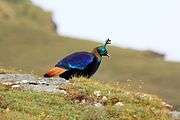 |
|
Biodiversity |
|
|
Conservation
|
|
Organisations |
|
Related topics |
Subclass: Theria
Infraclass: Eutheria
Order: Proboscidea (elephants)
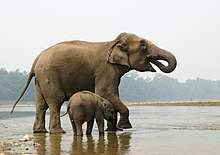
The elephants comprise three living species and are the largest living land animals.
- Family: Elephantidae (elephants)
- Genus: Elephas
- Asian elephant, Elephas maximus EN[1]
- Genus: Elephas
Order: Primates
The order Primates contains humans and their closest relatives: lemurs, lorisoids, monkeys, and apes.
- Suborder: Haplorhini
- Infraorder: Simiiformes
- Parvorder: Catarrhini
- Superfamily: Cercopithecoidea
- Family: Cercopithecidae (Old World monkeys)
- Genus: Macaca
- Assam macaque, M. assamensis NT[2]
- Rhesus macaque, M. mulatta LC[3]
- Subfamily: Colobinae
- Genus: Semnopithecus
- Nepal gray langur, S. schistaceus LC[4]
- Genus: Semnopithecus
- Genus: Macaca
- Family: Cercopithecidae (Old World monkeys)
- Superfamily: Cercopithecoidea
- Parvorder: Catarrhini
- Infraorder: Simiiformes
Order: Rodentia (rodents)
Rodents make up the largest order of mammals, with over 40% of mammalian species. They have two incisors in the upper and lower jaw which grow continually and must be kept short by gnawing. Most rodents are small though the capybara can weigh up to 45 kg (99 lb).
- Suborder: Hystricognathi
- Family: Hystricidae (Old World porcupines)
- Genus: Hystrix
- Malayan porcupine, H. brachyura VU
- Indian crested porcupine, H. indica LC
- Genus: Hystrix
- Family: Hystricidae (Old World porcupines)
- Suborder: Sciurognathi
- Family: Sciuridae (squirrels)
- Subfamily: Ratufinae
- Genus: Ratufa
- Black giant squirrel, Ratufa bicolor NT
- Genus: Ratufa
- Subfamily: Sciurinae
- Tribe: Pteromyini
- Genus: Belomys
- Hairy-footed flying squirrel, Belomys pearsonii DD
- Genus: Hylopetes
- Particolored flying squirrel, Hylopetes alboniger EN
- Genus: Petaurista
- Spotted giant flying squirrel, Petaurista elegans LC
- Hodgson's giant flying squirrel, Petaurista magnificus LC
- Bhutan giant flying squirrel, Petaurista nobilis NT
- Genus: Belomys
- Tribe: Pteromyini
- Subfamily: Callosciurinae
- Genus: Callosciurus
- Irrawaddy squirrel, C. pygerythrus LC[5]
- Genus: Dremomys
- Orange-bellied Himalayan squirrel, Dremomys lokriah LC
- Genus: Funambulus
- Northern palm squirrel, Funambulus pennantii LC
- Genus: Tamiops
- Himalayan striped squirrel, Tamiops macclellandi LC
- Genus: Callosciurus
- Subfamily: Ratufinae
- Family: Spalacidae
- Subfamily: Rhizomyinae
- Genus: Cannomys
- Lesser bamboo rat, Cannomys badius LC
- Genus: Cannomys
- Subfamily: Rhizomyinae
- Family: Cricetidae
- Subfamily: Cricetinae
- Genus: Cricetulus
- Tibetan dwarf hamster, Cricetulus alticola LC
- Genus: Cricetulus
- Subfamily: Arvicolinae
- Subfamily: Cricetinae
- Family: Muridae (mice, rats, voles, gerbils, hamsters, etc.)
- Subfamily: Gerbillinae
- Genus: Tatera
- Indian gerbil, Tatera indica LC
- Genus: Tatera
- Subfamily: Murinae
- Genus: Apodemus
- Himalayan field mouse, Apodemus gurkha LC
- Kashmir field mouse, Apodemus rusiges LC
- Ward's field mouse, Apodemus wardi LC
- Genus: Bandicota
- Greater bandicoot rat, Bandicota indica LC
- Genus: Dacnomys
- Millard's rat, Dacnomys millardi LC
- Genus: Diomys
- Crump's mouse, Diomys crumpi DD
- Genus: Millardia
- Soft-furred rat, Millardia meltada LC
- Genus: Mus
- Little Indian field mouse, Mus booduga LC
- Fawn-colored mouse, Mus cervicolor LC
- Cook's mouse, Mus cookii LC
- Rock-loving mouse, Mus saxicola LC
- Earth-colored mouse, Mus terricolor LC
- Genus: Niviventer
- Smoke-bellied rat, Niviventer eha LC
- Chestnut white-bellied rat, Niviventer fulvescens LC
- White-bellied rat, Niviventer niviventer LC
- Genus: Rattus
- Himalayan field rat, Rattus nitidus LC
- Sikkim rat, Rattus sikkimensis VU
- Tanezumi rat, Rattus tanezumi LC
- Turkestan rat, Rattus turkestanicus LC
- Genus: Vandeleuria
- Asiatic long-tailed climbing mouse, Vandeleuria oleracea LC
- Genus: Apodemus
- Subfamily: Gerbillinae
- Family: Sciuridae (squirrels)
Order: Lagomorpha (lagomorphs)
The lagomorphs comprise two families, Leporidae (hares and rabbits), and Ochotonidae (pikas). Though they can resemble rodents, and were classified as a superfamily in that order until the early 20th century, they have since been considered a separate order. They differ from rodents in a number of physical characteristics, such as having four incisors in the upper jaw rather than two.
- Family: Ochotonidae (pikas)
- Genus: Ochotona
- Black-lipped pika, Ochotona curzoniae LC
- Himalayan pika, Ochotona himalayana LC
- Large-eared pika, Ochotona macrotis LC
- Nubra pika, Ochotona nubrica LC
- Royle's pika, Ochotona roylei LC
- Genus: Ochotona
- Family: Leporidae (rabbits, hares)
- Genus: Caprolagus
- Hispid hare, Caprolagus hispidus EN
- Genus: Lepus
- Woolly hare, Lepus oiostolus LC
- Genus: Caprolagus
Order: Soricomorpha (shrews, moles, and solenodons)
The "shrew-forms" are insectivorous mammals. The shrews and solenodons closely resemble mice while the moles are stout-bodied burrowers.
- Family: Soricidae (shrews)
- Subfamily: Crocidurinae
- Genus: Crocidura
- Grey shrew, Crocidura attenuata LC
- Horsefield's shrew, Crocidura horsfieldii LC
- Genus: Suncus
- Etruscan shrew, Suncus etruscus LC
- Asian house shrew, Suncus murinus LC
- Anderson's shrew, Suncus stoliczkanus LC
- Genus: Soriculus
- Long-tailed brown-toothed shrew, Soriculus leucops LC
- Long-tailed mountain shrew, Soriculus macrurus LC
- Himalayan shrew, Soriculus nigrescens LC
- Tribe: Soricini
- Genus: Sorex
- Eurasian pygmy shrew, Sorex minutus LC
- Genus: Sorex
- Genus: Crocidura
- Subfamily: Crocidurinae
- Family: Talpidae (moles)
- Subfamily: Talpinae
- Tribe: Talpini
- Genus: Euroscaptor
- Himalayan mole, Euroscaptor micrura LC
- Genus: Euroscaptor
- Tribe: Talpini
- Subfamily: Talpinae
Order: Chiroptera (bats)
The bats' most distinguishing feature is that their forelimbs are developed as wings, making them the only mammals capable of flight. Bat species account for about 20% of all mammals.
- Family: Pteropodidae (flying foxes, Old World fruit bats)
- Subfamily: Pteropodinae
- Genus: Cynopterus
- Lesser short-nosed fruit bat, Cynopterus brachyotis LC
- Greater short-nosed fruit bat, Cynopterus sphinx LC
- Genus: Macroglossus
- Long-tongued fruit bat, Macroglossus sobrinus LC
- Genus: Pteropus
- Indian flying fox, Pteropus giganteus LC
- Genus: Rousettus
- Leschenault's rousette, Rousettus leschenaulti LC
- Genus: Sphaerias
- Blanford's fruit bat, Sphaerias blanfordi LC
- Genus: Cynopterus
- Subfamily: Pteropodinae
- Family: Hipposideridae (leaf nosed bats)
- Genus: Coelops
- East Asian tailless leaf-nosed bat, Coelops frithii
- Genus: Hipposideros
- Ashy roundleaf bat, Hipposideros cineraceus
- Fulvus roundleaf bat, Hipposideros fulvus
- Indian roundleaf bat, Hipposideros lankadiva
- Intermediate roundleaf bat, Hipposideros larvatus
- Pomona roundleaf bat, Hipposideros pomona
- Genus: Coelops
- Family: Megadermatidae
- Genus: Megaderma (false vampire bats)
- Greater false vampire bat, Megaderma lyra LC
- Genus: Megaderma (false vampire bats)
- Family: Vespertilionidae
- Subfamily: Kerivoulinae
- Genus: Kerivoula
- Painted bat, Kerivoula picta LC
- Genus: Kerivoula
- Subfamily: Myotinae
- Genus: Myotis
- Csorba's mouse-eared bat, Myotis csorbai DD
- Daubenton's bat, Myotis daubentonii
- Hodgson's bat, Myotis formosus
- Kashmir cave bat, Myotis longipes VU
- Whiskered myotis, Myotis muricola LC
- Mandelli's mouse-eared bat, Myotis sicarius VU
- Himalayan whiskered bat, Myotis siligorensis LC
- Genus: Myotis
- Subfamily: Vespertilioninae
- Genus: Arielulus
- Black-gilded pipistrelle, Arielulus circumdatus LC
- Genus: Barbastella
- Eastern barbastelle, Barbastella leucomelas LC
- Genus: Eptesicus
- Sombre bat, Eptesicus tatei
- Genus: Falsistrellus
- Chocolate pipistrelle, Falsistrellus affinis LC
- Genus: Hesperoptenus
- Tickell's bat, Hesperoptenus tickelli LC
- Genus: Ia
- Great evening bat, Ia io LC
- Genus: Nyctalus
- Mountain noctule, Nyctalus montanus LC
- Genus: Philetor
- Rohu's bat, Philetor brachypterus LC
- Genus: Pipistrellus
- Indian pipistrelle, Pipistrellus coromandra LC
- Java pipistrelle, Pipistrellus javanicus LC
- Chocolate pipistrelle, Falsistrellus affinis LC
- Genus: Scotomanes
- Harlequin bat, Scotomanes ornatus LC
- Lesser Asiatic yellow bat, Scotophilus kuhlii LC
- Greater Asiatic yellow bat, Scotophilus heathii LC
- Genus: Arielulus
- Subfamily: Murininae
- Genus: Murina
- Hutton's tube-nosed bat, Murina huttoni LC
- Greater tube-nosed bat, Murina leucogaster LC
- Genus: Murina
- Subfamily: Miniopterinae
- Genus: Miniopterus
- Small bent-winged bat, Miniopterus pusillus LC
- Schreibers' long-fingered bat, Miniopterus schreibersii LC
- Genus: Miniopterus
- Subfamily: Kerivoulinae
- Family: Molossidae
- Genus: Chaerephon
- Wrinkle-lipped free-tailed bat, Chaerephon plicata LC
- Genus: Chaerephon
- Family: Rhinolophidae
- Subfamily: Rhinolophinae
- Genus: Rhinolophus
- Intermediate horseshoe bat, Rhinolophus affinis LC
- Greater horseshoe bat, Rhinolophus ferrumequinum LC
- Blyth's horseshoe bat, Rhinolophus lepidus LC
- Woolly horseshoe bat, Rhinolophus luctus LC
- Big-eared horseshoe bat, Rhinolophus macrotis LC
- Pearson's horseshoe bat, Rhinolophus pearsoni LC
- Least horseshoe bat, Rhinolophus pusillus LC
- Rufous horseshoe bat, Rhinolophus rouxi LC
- Chinese rufous horseshoe bat, Rhinolophus sinicus LC
- Little Nepalese horseshoe bat, Rhinolophus subbadius DD
- Trefoil horseshoe bat, Rhinolophus trifoliatus LC
- Genus: Rhinolophus
- Subfamily: Hipposiderinae
- Genus: Hipposideros
- Great roundleaf bat, Hipposideros armiger LC
- Pomona roundleaf bat, Hipposideros pomona LC
- Genus: Hipposideros
- Subfamily: Rhinolophinae
Order: Pholidota (pangolins)
The order Pholidota comprises the eight species of pangolin. Pangolins are anteaters and have the powerful claws, elongated snout and long tongue seen in the other unrelated anteater species.
- Family: Manidae
- Genus: Manis
- Chinese pangolin, M. pentadactyla CR[6]
- Indian pangolin, M. crassicaudata EN[7]
- Genus: Manis
Order: Cetacea (whales)
The order Cetacea includes whales, dolphins and porpoises. They are the mammals most fully adapted to aquatic life with a spindle-shaped nearly hairless body, protected by a thick layer of blubber, and forelimbs and tail modified to provide propulsion underwater.
- Suborder: Odontoceti
- Superfamily: Platanistoidea
- Family: Platanistidae
- Genus: Platanista
- Ganges and Indus river dolphin, P. gangetica EN
- Genus: Platanista
- Family: Platanistidae
- Superfamily: Platanistoidea
Order: Carnivora (carnivorans)
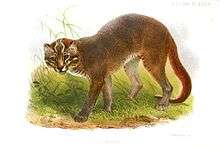
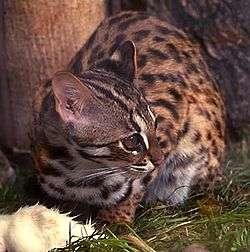
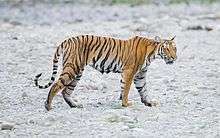
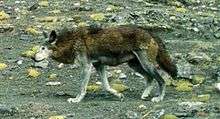
.jpg)
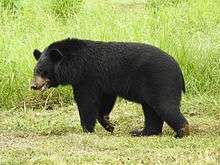
There are over 260 species of carnivorans; the majority primarily eat meat. They have a characteristic skull shape and dentition.
- Suborder: Feliformia
- Family: Felidae (cats)
- Subfamily: Felinae
- Genus: Catopuma
- Asian golden cat, C. temminckii NT[8]
- Genus: Felis
- Jungle cat, F. chaus LC[9]
- Genus: Lynx
- Eurasian lynx, L. lynx LC[10]
- Genus: Otocolobus
- Pallas's cat, O. manul NT[11]
- Genus: Prionailurus
- Leopard cat, P. bengalensis LC[12]
- Fishing cat, P. viverrinus VU[13]
- Rusty-spotted cat, P. rubiginosus NT[14]
- Genus: Catopuma
- Subfamily: Pantherinae
- Genus: Neofelis
- Clouded leopard, N. nebulosa VU[15]
- Genus: Panthera
- Snow leopard, P. uncia EN[16]
- Leopard, P. pardus VU[17]
- Indian leopard, P. pardus fusca
- Tiger, P. tigris EN[18]
- Bengal tiger, P. tigris tigris
- Genus: Neofelis
- Subfamily: Felinae
- Family: Viverridae
- Subfamily: Paradoxurinae
- Genus: Arctictis
- Genus: Paradoxurus
- Asian palm civet, P. hermaphroditus LC[20]
- Genus: Paguma
- Masked palm civet, P. larvata LC[21]
- Subfamily: Viverrinae
- Genus: Viverra
- Large Indian civet, V. zibetha LC[22]
- Genus: Viverricula
- Small Indian civet, V. indica LC[23]
- Genus: Viverra
- Subfamily: Prionodontinae
- Genus: Prionodon
- Spotted linsang, P. pardicolor LC
- Genus: Prionodon
- Subfamily: Paradoxurinae
- Family: Herpestidae (mongooses)
- Genus: Herpestes
- Indian grey mongoose, H. edwardsii LC[24]
- Javan mongoose, H. javanicus LC[25]
- Crab-eating mongoose, H. urva LC
- Ruddy mongoose, H. smithii LC
- Genus: Herpestes
- Family: Hyaenidae (hyaenas)
- Genus: Hyaena
- Striped hyena, H. hyaena LC[26]
- Genus: Hyaena
- Family: Felidae (cats)
- Suborder: Caniformia
- Family: Ailuridae (lesser panda)
- Family: Canidae (dogs, foxes)
- Genus: Canis
- Golden jackal, C. aureus LC[27]
- Gray wolf, C. lupus LC[28]
- Genus: Cuon
- Genus: Vulpes
- Bengal fox, V. bengalensis LC[30]
- Red fox, V. vulpes LC[31]
- Tibetan fox, V. ferrilata LC
- Genus: Canis
- Family: Ursidae (bears)
- Genus: Ursus
- Brown bear, U. arctos LC[32]
- Asiatic black bear, U. thibetanus VU[33]
- Genus: Melursus
- Sloth bear, M. ursinus VU
- Genus: Ursus
- Family: Mustelidae (mustelids)
- Genus: Mustela
- Yellow-bellied weasel, M. kathiah LC
- Siberian weasel, M. sibirica LC
- Genus: Martes
- Yellow-throated marten, M. flavigula LC[34]
- Genus: Mellivora
- Honey badger, M. capensis LC[35]
- Genus: Lutrogale
- Smooth-coated otter, L. perspicillata VU[36]
- Genus: Aonyx
- Asian small-clawed otter, A. cinereus VU[37]
- Genus: Mustela
Order: Perissodactyla (odd-toed ungulates)
The odd-toed ungulates are browsing and grazing mammals. They are usually large to very large, and have relatively simple stomachs and a large middle toe.
- Family: Rhinocerotidae
- Genus: Rhinoceros
- Indian rhinoceros, R. unicornis VU[38]
- Genus: Rhinoceros
Order: Artiodactyla (even-toed ungulates)
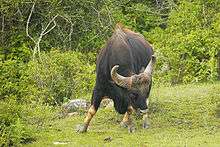

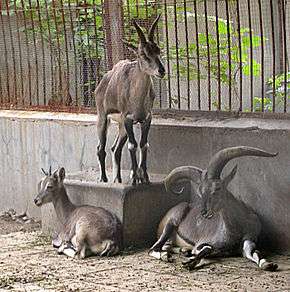
The even-toed ungulates are ungulates whose weight is borne about equally by the third and fourth toes, rather than mostly or entirely by the third as in perissodactyls. There are about 220 artiodactyl species, including many that are of great economic importance to humans.
- Family: Suidae (pigs)
- Family: Tragulidae
- Genus: Moschiola
- Indian spotted chevrotain, M. indica LC
- Genus: Moschiola
- Family: Moschidae
- Genus: Moschus
- White-bellied musk deer, M. chrysogaster EN
- Black musk deer, M. fuscus EN
- Genus: Moschus
- Family: Cervidae (deer)
- Subfamily: Cervinae
- Genus: Rucervus
- Barasingha, R. duvaucelii VU[39]
- Genus: Axis
- Chital, A. axis LC
- Genus: Rucervus
- Subfamily: Muntiacinae
- Genus: Muntiacus
- Indian muntjac, Muntiacus muntjak LC
- Genus: Muntiacus
- Subfamily: Cervinae
- Family: Bovidae (cattle, antelope, sheep, goats)
- Subfamily: Antilopinae
- Subfamily: Bovinae
- Genus: Bos
- Genus: Bubalus
- Wild water buffalo, B. arnee EN[41]
- Genus: Tetracerus
- Four-horned antelope, T. quadricornis VU
- Subfamily: Caprinae
- Genus: Hemitragus
- Himalayan tahr, H. jemlahicus NT
- Genus: Nemorhaedus
- Himalayan serow, N. thar NT
- Genus: Pseudois
- Bharal, P. nayaur LC
- Genus: Hemitragus
See also
References
- Choudhury, A.; Lahiri Choudhury, D. K.; Desai, A.; Duckworth, J. W.; Easa, P. S.; Johnsingh, A. J. T.; Fernando, P.; Hedges, S.; Gunawardena, M.; Kurt, F.; Karanth, U; Lister, A.; Menon, V.; Riddle, H.; Rübel, A.; Wikramanayake, E. (2008). "Elephas maximus". IUCN Red List of Threatened Species. 2008: e.T7140A12828813.
- Boonratana, R.; Chalise, M.; Das, J.; Htun, S. & Timmins, R. J. (2008). "Macaca assamensis". IUCN Red List of Threatened Species. 2008: e.T12549A3354977.
- Timmins, R. J.; Richardson, M.; Chhangani, A.; Yongcheng, L. (2008). "Macaca mulatta". IUCN Red List of Threatened Species. 2008: e.T12554A3356486.
- Kumar, A.; Yongzu, Z. & Molur, S. (2008). "Semnopithecus schistaceus". IUCN Red List of Threatened Species. 2008: e.T39840A10275563.
- Duckworth, J. W. (2016). "Callosciurus pygerythrus". IUCN Red List of Threatened Species. 2016: e.T3604A22253451.
- Challender, D.; Wu, S.; Kaspal, P.; Khatiwada, A.; Ghose, A.; Ching-Min Su, N. & Laxmi Suwal, T. (2019). "Manis pentadactyla". IUCN Red List of Threatened Species. 2019: e.T12764A123585318.
- Mahmood, T.; Challender, D.; Khatiwada, A.; Andleeb, S.; Perera, P.; Trageser, S.; Ghose, A. & Mohapatra, R. (2019). "Manis crassicaudata". IUCN Red List of Threatened Species. 2019: e.T12761A123583998.
- McCarthy, J.; Dahal, S.; Dhendup, T.; Gray, T.N.E.; Mukherjee, S.; Rahman, H.; Riordan, P.; Boontua, N. & Wilcox, D. (2015). "Catopuma temminckii". IUCN Red List of Threatened Species. 2015: e.T4038A97165437.
- Gray, T.N.E.; Timmins, R.J.; Jathana, D.; Duckworth, J.W.; Baral, H. & Mukherjee, S. (2016). "Felis chaus". IUCN Red List of Threatened Species. 2016: e.T8540A50651463.
- Breitenmoser, U.; Breitenmoser-Würsten, C.; Lanz, T.; von Arx, M.; Antonevich, A.; Bao, W. & Avgan, B. (2015). "Lynx lynx". IUCN Red List of Threatened Species. 2015: e.T12519A121707666.
- Ross, S.; Barashkova, A.; Farhadinia, M. S.; Appel, A.; Riordan, P.; Sanderson, J. & Munkhtsog, B. (2016). "Otocolobus manul". IUCN Red List of Threatened Species. 2016: e.T15640A87840229.
- Ross, J.; Brodie, J.; Cheyne, S.; Hearn, A.; Izawa, M.; Loken, B.; Lynam, A.; McCarthy, J.; Mukherjee, S.; Phan, C.; Rasphone, A. & Wilting, A. (2015). "Prionailurus bengalensis". IUCN Red List of Threatened Species. 2015: e.T18146A50661611.
- Mukherjee, S.; Appel, A.; Duckworth, J. W.; Sanderson, J.; Dahal, S.; Willcox, D. H. A.; Herranz Muñoz, V.; Malla, G.; Ratnayaka, A.; Kantimahanti, M.; Thudugala, A.; Thaung, R.; Rahman, H. (2016). "Prionailurus viverrinus". IUCN Red List of Threatened Species. 2016: e.T18150A50662615.
- Mukherjee, S.; Duckworth, J. W.; Silva, A.; Appel, A. & Kittle, A. (2016). "Prionailurus rubiginosus". IUCN Red List of Threatened Species. 2016: e.T18149A50662471. Retrieved 18 October 2018.
- Grassman, L.; Lynam, A.; Mohamad, S.; Duckworth, J. W.; Borah, J.; Willcox, D.; Ghimirey, Y.; Reza, A. & Rahman, H. (2016). "Neofelis nebulosa". IUCN Red List of Threatened Species. 2016: e.T14519A97215090.
- McCarthy, T.; Mallon, D.; Jackson, R.; Zahler, P. & McCarthy, K. (2017). "Panthera uncia". IUCN Red List of Threatened Species. 2017: e.T22732A50664030.
- Stein, A.B.; Athreya, V.; Gerngross, P.; Balme, G.; Henschel, P.; Karanth, U.; Miquelle, D.; Rostro-Garcia, S.; Kamler, J. F.; Laguardia, A.; Khorozyan, I. & Ghoddousi, A. (2019). "Panthera pardus". IUCN Red List of Threatened Species. 2019: e.T15954A160698029.
- Goodrich, J.; Lynam, A.; Miquelle, D.; Wibisono, H.; Kawanishi, K.; Pattanavibool, A.; Htun, S.; Tempa, T.; Karki, J.; Jhala, Y. & Karanth, U. (2015). "Panthera tigris". IUCN Red List of Threatened Species. 2015: e.T15955A50659951.
- Willcox, D.H.A.; Chutipong, W.; Gray, T.N.E.; Cheyne, S.; Semiadi, G.; Rahman, H.; Coudrat, C.N.Z.; Jennings, A.; Ghimirey, Y.; Ross, J.; Fredriksson, G.; Tilker, A. (2016). "Arctictis binturong". IUCN Red List of Threatened Species. 2016: e.T41690A45217088. Retrieved 13 January 2020.
- Duckworth, J.W.; Timmins, R.J.; Choudhury, A.; Chutipong, W.; Willcox, D.H.A.; Mudappa, D.; Rahman, H.; Widmann, P.; Wilting, A. & Xu, W. (2016). "Paradoxurus hermaphroditus". IUCN Red List of Threatened Species. 2016: e.T41693A45217835.
- Duckworth, J.W.; Timmins, R.J.; Chutipong, W.; Choudhury, A.; Mathai, J.; Willcox, D.H.A.; Ghimirey, Y.; Chan, B. & Ross, J. (2016). "Paguma larvata". IUCN Red List of Threatened Species. 2016: e.T41692A45217601.
- Timmins, R.J.; Duckworth, J.W.; Chutipong, W.; Ghimirey, Y.; Willcox, D.H.A.; Rahman, H.; Long, B. & Choudhury, A. (2016). "Viverra zibetha". IUCN Red List of Threatened Species. 2016: e.T41709A45220429. Retrieved 29 October 2018.
- Choudhury, A.; Duckworth, J.W.; Timmins, R.; Chutipong, W.; Willcox, D.H.A.; Rahman, H.; Ghimirey, Y. & Mudappa, D. (2015). "Viverricula indica". IUCN Red List of Threatened Species. 2015: e.T41710A45220632. Retrieved 29 October 2018.
- Mudappa, D.; Choudhury, A. (2016). "Herpestes edwardsii". IUCN Red List of Threatened Species. 2016: e.T41611A45206787.
- Chutipong, W.; Duckworth, J. W.; Timmins, R.; Willcox, D. H. A. & Ario, A. (2016). "Herpestes javanicus". IUCN Red List of Threatened Species. 2016: e.T70203940A45207619.
- AbiSaid, M. & Dloniak, S.M.D. (2015). "Hyaena hyaena". IUCN Red List of Threatened Species. 2015: e.T10274A45195080.
- Hoffmann, M.; Arnold, J.; Duckworth, J. W.; Jhala, Y.; Kamler, J. F. & Krofel, M. (2018). "Canis aureus". IUCN Red List of Threatened Species. 2018: e.T118264161A46194820.
- Boitani, L.; Phillips, M. & Jhala, Y. (2018). "Canis lupus". IUCN Red List of Threatened Species. 2018: e.T3746A119623865.
- Kamler, J. F.; Songsasen, N.; Jenks, K.; Srivathsa, A.; Sheng, L. & Kunkel, K. (2015). "Cuon alpinus". IUCN Red List of Threatened Species. 2015: e.T5953A72477893.
- Jhala, Y.V. (2016). "Vulpes bengalensis". IUCN Red List of Threatened Species. 2016: e.T23049A81069636.
- Hoffmann, M. & Sillero-Zubiri, C. (2016). "Vulpes vulpes". IUCN Red List of Threatened Species. 2016: e.T23062A46190249.
- McLellan, B. N.; Proctor, M. F.; Huber, D. & Michel, S. (2017). "Ursus arctos". IUCN Red List of Threatened Species. 2017: e.T41688A121229971.
- Garshelis, D. L. & Steinmetz, R. (2016). "Ursus thibetanus". IUCN Red List of Threatened Species. 2016: e.T22824A114252336.
- Chutipong, W.; Duckworth, J.W.; Timmins, R.J.; Choudhury, A.; Abramov, A.V.; Roberton, S.; Long, B.; Rahman, H.; Hearn, A.; Dinets, V. & Willcox, D.H.A. (2016). "Martes flavigula". IUCN Red List of Threatened Species. 2016: e.T41649A45212973.
- Do Linh San, E.; Begg, C.; Begg, K. & Abramov, A. V. (2016). "Mellivora capensis". IUCN Red List of Threatened Species. 2016: e.T41629A45210107.
- de Silva, P.; Khan, W.A.; Kanchanasaka, B.; Reza Lubis, I.; Feeroz, M. M.; Al-Sheikhly, O.F. (2015). "Lutrogale perspicillata". IUCN Red List of Threatened Species. 2015: e.T12427A21934884.
- Wright, L.; de Silva, P.; Chan, B.; Reza Lubis, I. (2015). "Aonyx cinereus". IUCN Red List of Threatened Species. 2015: e.T44166A21939068. Retrieved 29 October 2018.
- Talukdar, B. K.; Emslie, R.; Bist, S. S.; Choudhury, A.; Ellis, S.; Bonal, B. S.; Malakar, M. C.; Talukdar, B. N.; Barua, M. (2008). "Rhinoceros unicornis". IUCN Red List of Threatened Species. 2008: e.T19496A8928657. Retrieved 29 October 2018.
- Duckworth, J. W.; Kumar, N.S.; Pokharel, C.P.; Baral, H. S. & Timmins, R. J. (2015). "Rucervus duvaucelii". IUCN Red List of Threatened Species. 2015: e.T4257A22167675. Retrieved 29 October 2018.
- Duckworth, J. W.; Sankar, K.; Williams, A. C.; Samba Kumar, N. & Timmins, R. J. (2016). "Bos gaurus". IUCN Red List of Threatened Species. 2016: e.T2891A46363646. Retrieved 14 January 2018.
- Kaul, R.; Williams, A.C.; Steinmetz, R. & Mishra, R. (2019). "Bubalus arnee". IUCN Red List of Threatened Species. 2019: e.T3129A46364616.
External links
- "Animal Diversity Web". University of Michigan Museum of Zoology. 1995–2006. Retrieved 22 May 2007.
